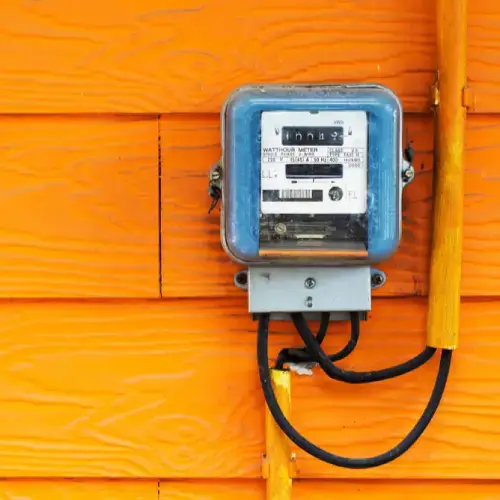Home / Compare Electricity &… / What is a controlled loa…

Key takeaways
If you have a pool pump or electric hot water system, you could potentially save on your energy bills with a controlled load tariff. Our guide will take you through what controlled load tariffs are, how you can benefit and if you’re eligible for them.
- Controlled load tariffs aren’t suitable to every household as they only apply to heavy-usage home appliances.
- To use this tariff, your home will either need to have its own meter for controlled loads, or a smart meter with a separate circuit.
- Depending on where you live, you may have more than one type of controlled load tariff to choose from.
What is a controlled load tariff?
A controlled load tariff (how you’re charged for electricity usage) is applied to specific home appliances that steadily use large amounts of electricity. These include pool pumps, underfloor or slab heaters and electric hot water systems.
Usually, these appliances are wired to their own circuits and have their own meters, separate from the rest of your household’s electricity supply (although they can also be on different circuits but the same meter; this is generally the case with smart meters). That way, your electricity provider (also known as your electricity retailer) can bill appliances with controlled load tariffs separately and often at a lower rate than the rest of your usage.
This is because controlled load appliances generally draw their electricity during off-peak times, like overnight or during the day when most people aren’t at home. The hours that make up off-peak times can differ between energy providers, as can the name of the controlled load tariff; some providers might refer to their controlled load tariffs as a ‘dedicated circuit’.
Keep in mind that controlled load tariffs will usually exist in addition to your single rate or time of use tariff, and may incur an additional daily supply fee on top of your regular electricity meter.
Expert tips for getting the most out of your controlled load tariff
Our Head of Energy, Meredith O’Brien, has some tips for understanding controlled load tariffs and helping you decide if they’re suitable for your household.

Check if you’re eligible
If you think you can benefit from a controlled load tariff, contact your provider first to find out whether this option is available to you.
Add your billing when comparing plans
If you have a separately charged controlled load appliance, remember to add your bill details if you want to compare controlled load tariffs. This will give you a better idea of what you’re likely to pay for electricity when doing a bill comparison.
Switch without disruptions
Switching electricity providers does not disrupt your energy supply and it can take as little as two business days to be transferred to your new provider.
Controlled loads explained
Types of controlled loads

New South Wales (NSW), Queensland (QLD) and Tasmania (TAS) offer two options for controlled load tariffs.
In NSW, these tariffs are:
- Controlled load 1
- Controlled load 2
In QLD, they are:
- Tariff 31
- Tariff 33
In TAS, the controlled load tariffs are:
- Tariff 61
- Tariff 63
Controlled load 1, tariff 31 and tariff 63 usage is generally available for a few hours each day (e.g. six hours, usually overnight), and tends to be cheaper than general electricity usage around the rest of the household.
However, controlled load 2, tariff 33 and tariff 61 are generally available for a longer period overnight as well as a couple more hours during the day. In turn, they’re slightly more expensive than the other tariffs.
Other states and territories that offer controlled load electricity (e.g., Victoria, South Australia and Australian Capital Territory) may only have the one controlled load tariff available. Remember that a controlled load tariff may be called something different in your state, like ‘dedicated circuit’ or ‘economy-tariff’.
Is a controlled load right for me?
Controlled load tariffs are only suitable for certain appliances. If you have large appliances that draw considerable amounts of energy at the same time every day (like hot water systems and pool pumps), you could stand to benefit from a controlled load tariff.
If you don’t have these appliances, a controlled load isn’t right for you. It isn’t designed for large amounts of electricity usage, like those used by multiple appliances during peak times.
If you find you have high energy use during certain times of the day (but not from controlled load appliances), you could look into a time-of-use or demand tariff. A time-of-use tariff charges you differently for electricity depending the times of day you use it. Conversely, a demand tariff applies a surcharge to your peak electricity usage during a designated peak electricity demand period in order to discourage using electricity bills (which may result in cheaper electricity bills).
Depending on what tariff you want, consider speaking to your provider as your current meter may not be able to support it.
How do I get a controlled load tariff for my appliance?
If your appliance doesn’t have its own meter, you may need to pay to get one installed or have an electrician reconfigure your current meter. Before making any decisions, be sure to contact your provider first to determine whether these options are available to you.
For an appliance already on its own meter, you’re likely to already have a separate controlled load tariff. Still, there’s no reason why you can’t switch providers for a better deal! To see if you’re on a great controlled load tariff, simply check your bill and compare between energy providers.
Are there concessions for controlled load electricity?
The Victoria State Government offers a concession specifically for controlled load electricity bills. To access this concession, you will need to hold a Pensioner Concession Card, Health Care Card or Veterans’ Affairs Gold Card and meet the other eligibility requirements.
Only households with dual-element electricity (a two-thermostat system in which the upper thermostat heats the water to a determined temperature before the lower heats to the final temperature) or smart meters (for hot water and slab heating) are eligible for the 13% discount.1
Of course, energy rebates and concessions aimed at assisting households with electricity costs are available from every state and territory government; they just might not be specifically for your controlled load bill. If you’re struggling to pay your energy bills, reaching out to your energy provider (who usually arranges the concessions for you) is the best way to move forward. However, if you live in SA, you will need to apply directly with the Australian Department of Human Services (DHS) for any energy concessions.2
More on electricity tariffs
What is an electricity tariff?
Electricity tariffs are how much your household or business is charged for your electricity usage. It comprises of the daily supply charge (the cost to deliver the electricity to your property) and the usage charge (how much electricity you use).
Keep in mind, the daily supply charge may apply per meter depending on your retailer, so by having a controlled load you may be subject to an additional charge.
What is a feed-in tariff?
Solar feed-in tariffs are only applicable if you have solar photovoltaic (PV) panels installed on the roof of your home. Feed-in tariffs allow you to earn credit toward your electricity bill by sending your surplus solar energy back to the electricity grid.
Most providers can set their own rates for feed-in tariffs. The only exception is Victoria; which has a minimum flat rate feed-in tariff and two time-varying feed-in tariff options. Therefore, it can be worth shopping around to find the most suitable option for you. If you’re unsure which provider would best suit you, you can use our free comparison tool to compare tariffs, usage rates and more.
How can I take advantage of off-peak times if I don’t have controlled load appliances?
Even if you don’t have underfloor heating, pool pumps or other appliances that have high energy usage, you can still take advantage of peak, off-peak and shoulder times through a time-of-use tariff.
If you have this tariff (which generally requires a smart meter), your electricity usage will be measured and charged according to the time of day you consume it.
Usage during peak periods (e.g. mornings and evenings on weekdays for certain tariffs) will cost you more than usage during off-peak (e.g. overnight or during the day) or shoulder (between the peak and off-peak), with off-peak usage costing you the least of the three.
If they’re available, peak, off-peak and shoulder times will vary between providers.
Meet our energy expert, Meredith O’Brien
As the Head of Energy at Compare the Market, Meredith O’Brien believes in educating Australian customers about the everchanging gas and electricity market so they can adjust their energy usage habits and get the most out of their energy plans.
Meredith has six years within the energy industry, following 15 years of experience in financial services and is currently studying a Master of Business Administration. Meredith is a dedicated customer advocate who is passionate about empowering Australians to find the right products to suit their needs by removing the confusion from comparing.
Want to know more about energy?
1 Victoria State Government. Controlled load electricity concession. Accessed October 2023.
2 Government of South Australia – Human Services. Energy bill concessions. Accessed October 2023.


